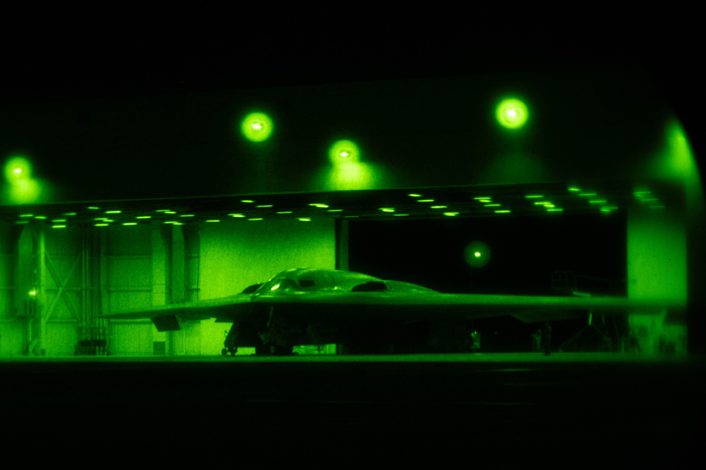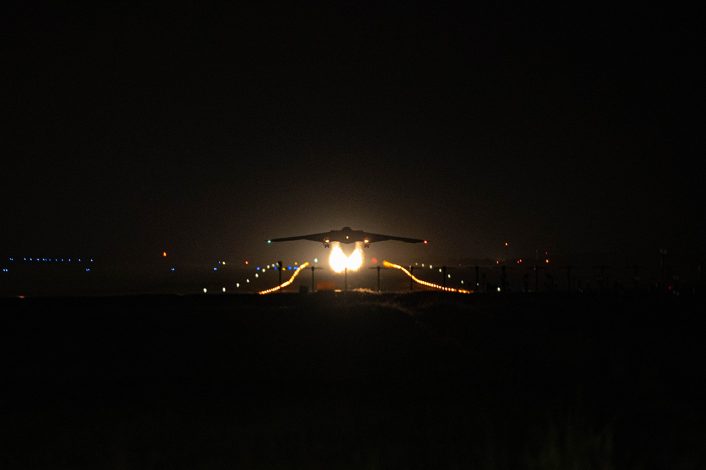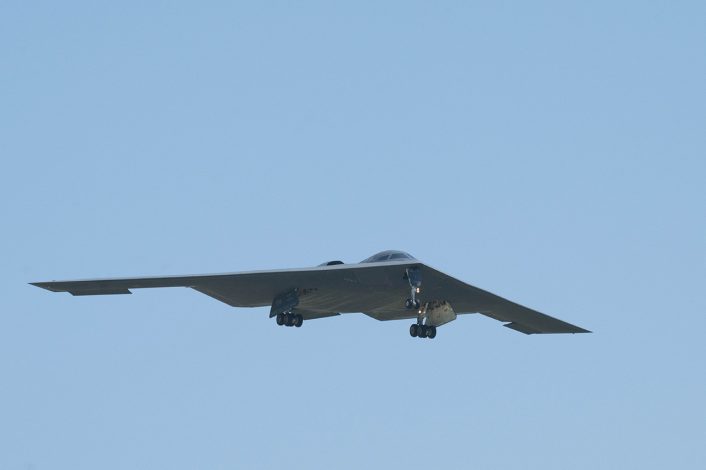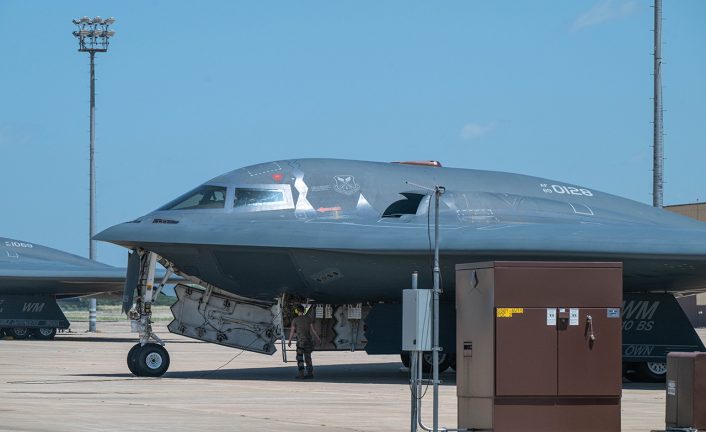Official images show B-2 Spirit stealth bombers being prepared, departing, and returning to Whiteman AFB as part of the U.S. operation against Iranian nuclear sites.
Operation Midnight Hammer involved over 125 aircraft, and saw U.S. Air Force B-2 Spirits fly continuously for 37 hours assisted by multiple air-to-air refuelings. The mission, targeting sites associated with Iran’s nuclear program, has been in the making for decades and was well rehearsed by both U.S. and Israeli forces.
Images from the raid, conducted not only in secret but additionally under the cover of diversionary flights heading the opposite direction, have now been cleared for release by the U.S. military, offering an inside look at the B-2s departing from and arriving back at their base in Missouri.

What we don’t know about the images showing the preparation and departure of the B-2s is whether we are looking at aircraft involved in the strike, or those which flew west towards the Pacific in order to create a deception that protected the actual operation. Officials have noted that this mission was deemed necessary due to the large number of social media posts made by President Trump that threatened the mission’s secrecy. According to a military official who spoke anonymously to the New York Timesthe President himself was considered “biggest threat to OPSEC [operational security]”.
It is still unclear exactly how many B-2s were involved in the ‘decoy’ mission, as it was described by General Dan Caine, Chairman of the Joint Chiefs of Staff. Though neither set of B-2s were able to be tracked by flight tracking websites (it is possible that some had their transponders enabled, just not transmitting Mode S or ADS-B), aviation enthusiasts and open source intelligence analysts were able to monitor the massive trail of refueling tankers that supported the aircraft across the Pacific to Guam.
Lucas Tomlinson of Fox News reported that two B-2s were involved in this mission, but those who monitored the flight believed there were between six and eight. The number of tankers would support the latter, though it is possible this was part of the deception.
For clarification:
MYTEE11 FLT (4x B-2As)
Whiteman to Andersen AFB, Guam. MYTEE14 diverted into Honolulu.MYTEE21 FLT (4x B-2As)
Whiteman to Andersen AFB, Guam.BATT11 FLT (4x B-2As)
Flew eastbound via Atlantic to strike Iran.BATT21 FLT (3x B-2As)
Flew eastbound via…— Aircraft Spots (@AircraftSpots) June 22, 2025
Since the raid became public, reports of mass launches of tankers from European bases prior to the strike have surfaced. These tankers flew with degraded transponders – either off entirely, or more likely set to Mode 3 or Mode A/C only – this way, the aircraft are visible and identifiable by air traffic control, but not traceable by popular sites like Flightradar24 or ADS-B Exchange – but were nonetheless heard and/or seen by local enthusiasts. It’s very possible that had attention not been on the westbound B-2 group, more focus might have been drawn by these movements, as well as reports of nine B-2s heading east from Whiteman, leading to the actual strike package being revealed sooner.


At some point as the bombers entered the Middle East region, they were joined by U.S. Air Force fighter aircraft to provide protection from any remaining air defense threat. This would have almost certainly included F-22 Raptor and F-35 Lightning II stealth fighters which were rapidly deployed to CENTCOM in the aftermath of Israel’s initial strike. Among the 75 precision weapons deployed in the operation, a number are said to have pre-emptively targeted Iranian air defense sites along the B-2s’ flight path.
Combined with Israeli air defense suppression missions flown over the preceding 48 hours at the request of the U.S., this degraded Iranian defenses to a point where U.S. officials have publicly stated no launches were detected towards their aircraft. This stands in stark contrast to recent sorties over Yemen, where the Houthis, who have been supported by Iran, launched surface to air missiles against a large number of U.S. aircraft. F-16s and F-35s were unsuccessfully targeted by Houthi missiles, while multiple MQ-9 Reapers were shot down.
NEW: At the request of the Trump administration, the Israeli Air Force took out multiple Iranian air defense systems in the 48 hours leading up to the U.S. strike on Iran’s Fordow nuclear facility
— Axios (@axios.com) June 22, 2025 at 6:44 PM
After the completion of the strikes, which hit the Fordow and Natanz facilities (Isfahan was targeted by Tomahawk missiles launched by a U.S. submarine), the strike package B-2s returned along the same route they used on the inbound leg. Routing through the Mediterranean and across the Atlantic, this time many of their refueling aircraft were visible on flight tracking sites and enthusiasts were able to monitor both the B-2s and the tankers communicating with air traffic control. The B-2s, callsigns BATT 11 flight and BATT 21 flight, were also active on the U.S. Air Force High Frequency Global Communications System (HFGCS).
When they reached the U.S., air traffic controllers could be heard thanking the crews for their service as they passed between different airspace sectors.


Using the released images and video footage, we can see that among the B-2s utilized during the mission were 82-1069 ‘Spirit of Indiana’, 89-0128 ‘Spirit of Nebraska’, and 93-1088 ‘Spirit of Louisiana’.
The US Dept. of Defense has released video of US Air Force B-2 Spirits preparing for and returning from bombing Iran during Operation MIDNIGHT HAMMER. pic.twitter.com/CRBGgNXZZs
— TheIntelFrog (@TheIntelFrog) June 23, 2025
Conflicting reports regarding the effectiveness of the airstrikes quickly emerged, with Iranian claims disputing initial statements by President Trump suggesting that the nuclear facilities had been completely destroyed. It is difficult to ascertain which is the most accurate, but the likely state of affairs is probably somewhere in between.
Even if the facilities themselves were indeed destroyed, satellite imagery taken in the days prior to the mission suggest some materials may have been moved away from these high-profile sites as Iran anticipated strikes against them.
Satellite pictures taken before last night’s US strikes indicated unusual traffic movements at the Fordo nuclear plant in #Iranin images taken on June 19th and 20th released today by @Maxar Technologies.
On the 19th, 16 cargo trucks were seen across an access road leading to a… pic.twitter.com/pLtCZqMoIV
— Chris Partridge (@Chris1603) June 22, 2025
The US may not know the whereabouts of Iran’s roughly 400kg of highly-enriched uranium, which is small enough to fit in “the trunks of about 10 cars” pic.twitter.com/vbcMCHqSUr
— Evan Hill (@evanhill) June 22, 2025
Entrance tunnels to the Fordow complex, constructed deep inside a mountain, were noted in other imagery to be in the process of being filled in. This may have been to guard both against air attack but also the prospect of a special forces ground incursion, which had been suggested as Israel’s only way to successfully attack such a hardened target without direct U.S. support.
Short of nuclear weapons, huge 30,000 lb GBU-57 Massive Ordnance Penetrator (MOP) bunker busters were required to even gain a hope of damaging this site. Currently deployed only on the B-2, this necessitated the stealth bombers’ use. The new B-21 Raider will be able to carry the weapon, although it will carry a maximum of one compared to the B-2’s two. This would mean twice as many B-21s would be required to deliver the same mass as Midnight Hammer, though a theorized replacement for the MOP, aimed to be smaller and lightermight be able to be carried in greater quantities.
New high-resolution imagery, captured on June 21, 2025, suggests Iran was preparing the Fordow nuclear facility for a strike. The facility’s entrance tunnels were observed being filled with earth by trucks and diggers. pic.twitter.com/UyLBb5NETS
— Open Source Centre (@osc_london) June 22, 2025
Regardless of the weapons’ performance, the mammoth sortie proves the enduring capability of the U.S. Air Force’s B-2 Spirit and the crews that operate them even nearly 30 years on from their introduction to service. To accommodate such long flights, the B-2’s cockpit – designed primarily for two crew members, though with accommodation for three if necessary – features a large cockpit with enough space for a roll-up mattress behind the pilot seats. There is a toilet, microwave, and refrigerated storage provided to allow for all potential needs to be taken care of. You can read and see more about being inside the B-2’s cockpit in our exclusive 2019 interview with filmmaker Jeff Bolton.
The strike package B-2s arrived back at Whiteman AFB in the daytime, much more publicly than their middle-of-the-night departure.


Scheduled to retire in the early 2030s, the B-2’s participation in Operation Midnight Hammer may go down in history as the type’s most notable hour. First going to war in 1999, the aircraft has been employed over Iraq, Afghanistan, Libya, and Yemen. In 2011, B-2s were seemingly launched in an apparent contingency role during Operation Neptune Spear, likely intending to totally destroy Osama bin Laden’s compound in Abbottabad, Pakistan in the event the SEAL team raid was unsuccessful. As we know, though, the B-2s ended up not being required.


Despite the length of this mission, a previous B-2 mission still holds the record for the longest bomber raid in history. In 2001, B-2 82-1066 ‘Spirit of America’ was flown direct from Whiteman AFB to drop munitions on targets in Afghanistan. Even after the long flight to the target area, the B-2 was requested to remain on station over the country for two hours using the aircraft’s built in synthetic aperture radar to map the landscape and more precisely deliver twelve JDAM-equipped bombs.
When ‘Spirit of America’ finally touched the tarmac at Diego Garcia it had been airborne for over 44 hours – after 45 minutes on the ground being serviced, the aircraft departed again for Whiteman. In total, the B-2’s engines were running constantly for over 70 hours.
According, again, to Lucas Tomlinson of Fox Newsair force chiefs have quietly noted following Operation Midnight Hammer: “If you think the B-2 is impressive, wait until you see the B-21.”
Source link
[aviation news]
Share this content:


